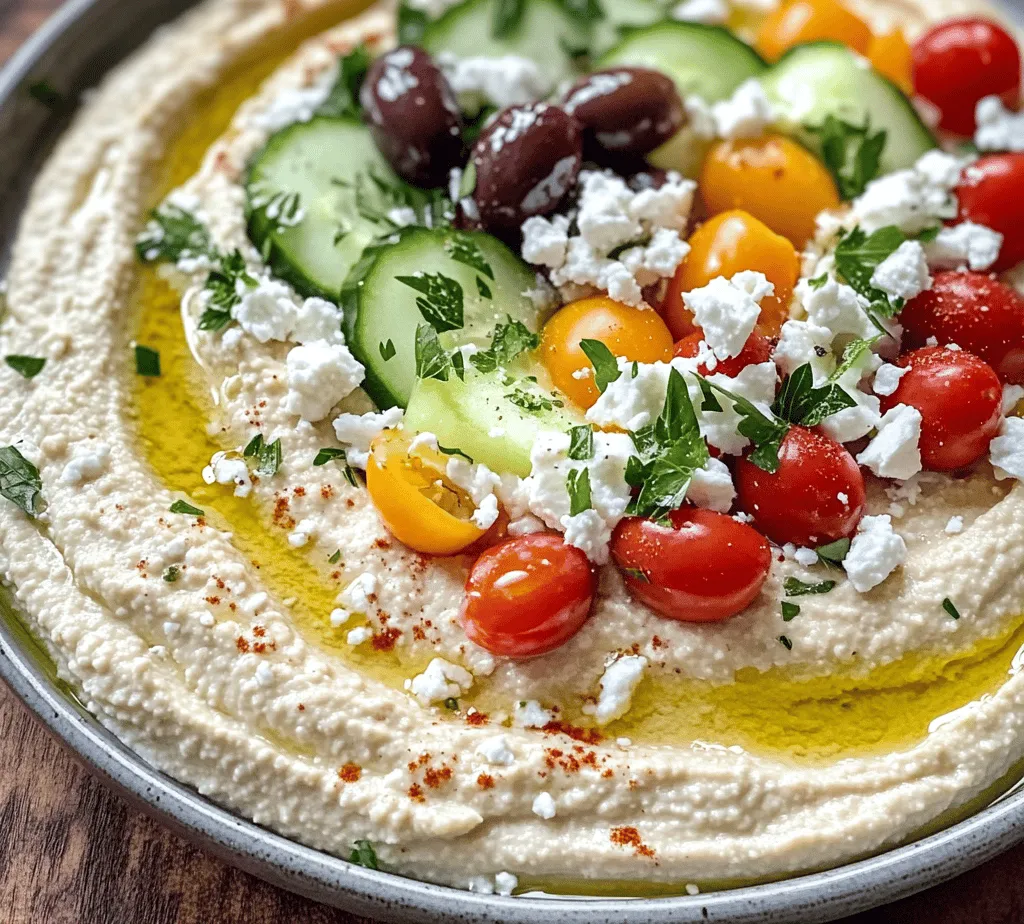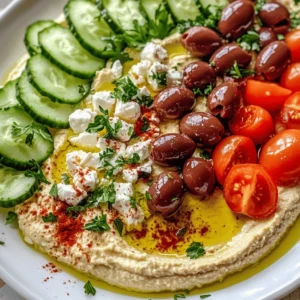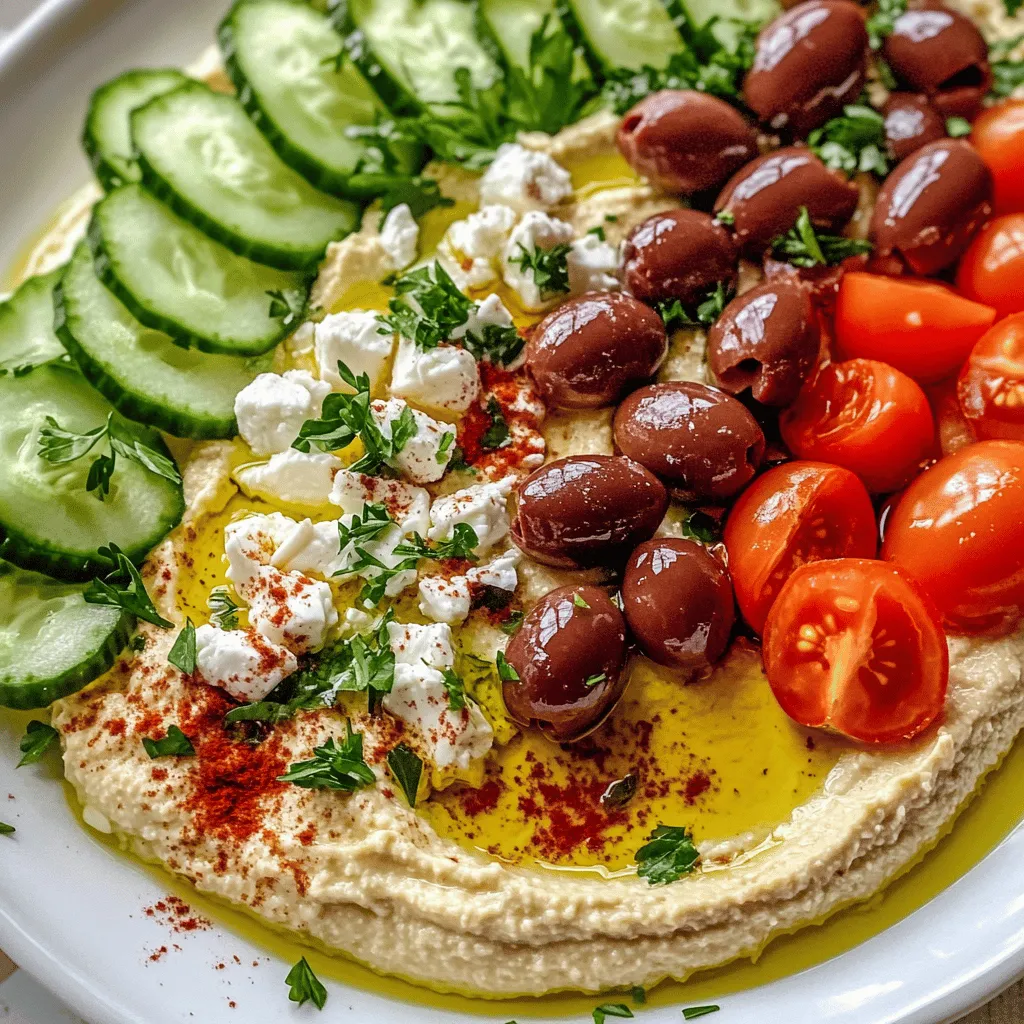Introduction
Hummus, a staple in Mediterranean cuisine, has captivated taste buds around the world with its creamy texture and rich flavor. This versatile dish, made primarily from chickpeas, has transcended its humble origins to become a beloved appetizer, snack, or even a meal in itself. With endless variations, hummus can be adapted to cater to different palates, making it a perfect choice for gatherings or casual snacking at home.
One of the most delightful interpretations of this classic dish is the Greek Style Loaded Hummus. This refreshing twist incorporates traditional Greek ingredients that elevate the flavor profile and add a vibrant touch to the presentation. The combination of creamy hummus topped with fresh vegetables, feta cheese, and a drizzle of olive oil creates an irresistible dish that is not only visually appealing but also packed with nutritional benefits.
Loaded hummus is not just a treat for the taste buds; it also boasts impressive health benefits. Chickpeas provide a rich source of plant-based protein and fiber, while tahini adds healthy fats. The inclusion of fresh vegetables contributes essential vitamins and minerals, making this dish a wholesome option for various diets, including vegan and vegetarian lifestyles. Whether served as an appetizer at a dinner party or enjoyed as a healthy snack between meals, Greek Style Loaded Hummus promises to satisfy and nourish.
The Rich History of Hummus
The origins of hummus can be traced back to the Middle East, where it has been enjoyed for centuries. While the exact birthplace of hummus is a topic of debate, it is widely believed to have been created in the Levant region, which includes modern-day countries like Lebanon, Israel, and Syria. The word “hummus” itself is derived from the Arabic word for chickpeas, “hummus,” highlighting its significance in Arabic culture and cuisine.
Hummus holds a special place in the culinary traditions of Greek and Mediterranean societies. It is often served as part of a mezze platter, a selection of small dishes meant for sharing, which reflects the communal dining culture prevalent in these regions. As the dish evolved over time, variations emerged, incorporating local ingredients and flavors. The addition of olive oil, garlic, and lemon juice became common, enhancing the taste and texture of this beloved dip.
Over the years, hummus has gained global popularity, transcending borders and becoming a favorite in many countries. Its rise to fame can be attributed to its versatility, health benefits, and the growing interest in Mediterranean diets, known for their emphasis on whole foods and healthy fats. Today, hummus can be found in grocery stores worldwide, with countless variations and flavors, from roasted red pepper to spicy harissa.
Ingredients Spotlight
Chickpeas
At the heart of every great hummus is the chickpea, a small but mighty legume. Chickpeas are known for their impressive nutritional profile, being rich in protein, fiber, and essential vitamins and minerals. They play a crucial role in the recipe, providing the creamy base that defines hummus. When blended, they create a smooth consistency that serves as the perfect canvas for additional flavors. Chickpeas are also low in calories, making them an excellent choice for those looking to maintain a healthy diet while enjoying a satisfying dish.
Tahini
One of the key ingredients that sets hummus apart is tahini, a paste made from ground sesame seeds. This ingredient is essential for achieving the creamy texture that hummus is famous for. Not only does tahini contribute to the smoothness of the dip, but it also adds a rich, nutty flavor that complements the chickpeas beautifully. Tahini is packed with healthy fats, calcium, and antioxidants, making it a nutritious addition to the recipe.
Olive Oil
No Mediterranean dish is complete without a generous drizzle of high-quality olive oil. Renowned for its flavor and health benefits, olive oil is an integral part of Greek Style Loaded Hummus. It not only enhances the taste but also adds a luxurious richness to the dish. Packed with monounsaturated fats and antioxidants, olive oil is celebrated for its anti-inflammatory properties and heart-healthy benefits. Using a good quality extra virgin olive oil can elevate the overall experience, providing a fragrant aroma and depth of flavor that ties all the ingredients together.
Greek Yogurt
In this Greek-inspired version of hummus, Greek yogurt is introduced as a key ingredient, setting it apart from traditional recipes. The addition of Greek yogurt brings an extra level of creaminess and tanginess, making the hummus even more luscious. Additionally, Greek yogurt is a fantastic source of protein and probiotics, promoting gut health. This ingredient not only enhances the flavor but also makes the hummus a heartier option, perfect for those looking to increase their protein intake.
Fresh Vegetables
The vibrant toppings of Greek Style Loaded Hummus are what truly make this dish shine. Fresh vegetables such as cucumbers, tomatoes, olives, and red onions are essential for adding crunch and freshness. Cucumbers provide a refreshing bite, while tomatoes add juiciness and sweetness. Olives, particularly Kalamata olives, contribute a briny depth of flavor that contrasts beautifully with the creamy hummus. Red onions, finely chopped, lend a sharpness that brightens the overall flavor profile. These vegetables not only enhance the taste but also provide a colorful presentation that is sure to impress.
Feta Cheese
A hallmark of Greek cuisine, feta cheese is a must-have topping for this loaded hummus. Its crumbly texture and tangy flavor add a delightful contrast to the creamy base. Feta cheese is made from sheep’s milk or a combination of sheep and goat’s milk, giving it a distinct taste that is both savory and slightly salty. It is rich in calcium and protein, making it a nutritious addition to the dish. The feta not only enhances the flavor but also adds a touch of authentic Greek flair to the loaded hummus.
Parsley
As a finishing touch, fresh parsley is often sprinkled on top of Greek Style Loaded Hummus. This herb adds a bright pop of color and freshness, elevating the dish visually and flavor-wise. Parsley is known for its antioxidant properties and provides a subtle, herbaceous note that complements the other ingredients. A sprinkle of parsley can transform the presentation, making the hummus even more inviting.
Step-by-Step Guide to Making Greek Style Loaded Hummus
Now that we’ve explored the ingredients that make Greek Style Loaded Hummus so special, let’s dive into the step-by-step process of making this delicious dish.
Preparing the Hummus Base
1. Gather Your Ingredients: Start by assembling all the necessary ingredients for the hummus base. You will need cooked chickpeas (canned or boiled), tahini, olive oil, lemon juice, garlic, and Greek yogurt.
2. Blend the Chickpeas: In a food processor, add the cooked chickpeas. If you’re using canned chickpeas, rinse and drain them thoroughly. For a smoother texture, you can peel the chickpeas, but this step is optional. Blend them until they form a coarse paste.
3. Add Tahini and Olive Oil: Next, add a few tablespoons of tahini and a drizzle of olive oil to the chickpeas. Blend again until the mixture becomes creamy and well combined.
4. Incorporate Greek Yogurt: To achieve that signature creaminess, add Greek yogurt to the mixture. This will also lend a tangy flavor. Blend until everything is fully incorporated.
5. Season to Taste: Squeeze in the juice of one lemon for acidity and freshness. Add minced garlic, salt, and pepper to taste. Blend again, adjusting the seasoning as needed. If the hummus is too thick, you can add a bit of cold water or more olive oil to achieve your desired consistency.
6. Taste and Adjust: Before serving, taste the hummus and adjust the seasoning if necessary. This is your chance to make it perfect to your liking!
Preparing the Vegetable Topping
1. Chop Fresh Vegetables: While the hummus is blending, take the time to prepare your vegetable topping. Dice fresh cucumbers, tomatoes, and red onions into small, bite-sized pieces. If using Kalamata olives, slice them in half to make them easier to scoop.
2. Mix for Flavor: In a bowl, combine the diced cucumbers, tomatoes, olives, and red onions. Drizzle with a little olive oil and sprinkle with salt and pepper. Toss gently to combine and allow the flavors to meld while you finish the hummus.
Assembling the Loaded Hummus
1. Transfer the Hummus: Once the hummus is ready, transfer it to a serving dish or platter. Use the back of a spoon to create a shallow well in the center of the hummus.
2. Add the Vegetable Topping: Spoon the prepared vegetable mixture into the well you created. Be generous with the toppings, as they are the star of this dish.
3. Finish with Feta and Olive Oil: Crumble feta cheese over the top of the loaded hummus and drizzle with additional olive oil for extra richness.
4. Garnish with Parsley: Finally, sprinkle freshly chopped parsley over the top for a pop of color and flavor.
With these steps, you’ve created a stunning Greek Style Loaded Hummus that’s perfect for sharing or enjoying on your own. The combination of creamy hummus, fresh vegetables, tangy feta, and vibrant herbs creates a dish that’s not only delicious but also a feast for the eyes.
Stay tuned for the next part of this article, where we will explore tips for achieving the best results with your hummus and answer some common questions about this delightful dish.

Tips on How to Properly Drizzle Olive Oil and Garnish for Visual Appeal
When it comes to serving Greek Style Loaded Hummus, presentation is key. A beautiful drizzle of high-quality olive oil not only enhances the dish’s flavor but also adds a touch of elegance. To achieve the perfect drizzle, use a squeeze bottle or a small measuring spoon. Start from the center of the hummus and work your way outward in a circular motion, allowing the oil to pool gently at the edges. This technique creates a visually appealing spiral that invites guests to dig in.
For garnishing, consider using a combination of fresh herbs and bright spices. Chopped parsley or cilantro can bring a pop of color, while a sprinkle of paprika or sumac adds an appealing contrast. Thinly sliced olives or cherry tomatoes can also be arranged artistically atop the hummus, creating an inviting landscape of flavors and textures. Don’t forget to add a few whole chickpeas for that authentic touch, making your hummus not only delicious but also visually stunning.
Flavor Pairing Suggestions
Greek Style Loaded Hummus is versatile and pairs well with a variety of dippers. Traditional pita bread is a classic choice, but feel free to experiment with different variations. Warm pita chips, crunchy pita triangles, or even pita bread baked with herbs can elevate the experience. For a healthier option, consider serving it with fresh vegetable sticks like carrots, cucumbers, bell peppers, and celery. These vegetables not only add a satisfying crunch but also contribute additional nutrients.
When it comes to beverages, consider serving your loaded hummus with a crisp white wine, such as a Sauvignon Blanc or a light-bodied red like Pinot Noir. Both options enhance the Mediterranean flavors without overpowering them. If you prefer non-alcoholic drinks, a refreshing mint lemonade or sparkling water with lemon can provide a bright complement to the dish.
For those planning a Mediterranean-themed meal or party, Greek Style Loaded Hummus can take center stage as part of a vibrant mezze platter. Include assorted olives, stuffed grape leaves, a selection of cheeses like feta or halloumi, and grilled vegetables to create a colorful and enticing spread. This approach not only showcases the hummus but also offers guests a variety of flavors to enjoy.
Nutritional Breakdown of Greek Style Loaded Hummus
One of the greatest benefits of Greek Style Loaded Hummus is its nutritional profile. A typical serving (about 1/4 cup) contains approximately 120-150 calories, making it a guilt-free option for snacking or as part of a meal. It is rich in protein, with chickpeas providing a substantial amount of plant-based protein, while olive oil contributes healthy fats essential for heart health.
In terms of vitamins and minerals, this dish is packed with nutrients. Chickpeas are an excellent source of fiber, which aids in digestion and helps maintain steady blood sugar levels. The addition of tahini offers calcium and magnesium, while garlic provides antioxidants that support the immune system. The fresh toppings like parsley and tomatoes add vitamin C and other antioxidants, further enhancing the health benefits of this delicious dish.
By choosing Greek Style Loaded Hummus, you are indulging in a dish that not only satisfies your cravings but also nourishes your body, making it an ideal addition to a balanced diet.
Variations and Customizations
One of the best aspects of Greek Style Loaded Hummus is its versatility. You can easily customize the recipe to fit various dietary needs and preferences. For a gluten-free option, simply serve the hummus with gluten-free dippers like rice crackers or veggie sticks. If you need a nut-free alternative, you can replace tahini with sunflower seed butter or skip it entirely without sacrificing taste.
For those looking to add more flavor or texture, consider experimenting with different toppings. Roasted red peppers can bring a sweet smokiness, while diced avocado adds creaminess. If you enjoy a bit of spice, a sprinkle of chili flakes or some diced jalapeños can elevate the dish to new heights. Seasonal ingredients can also be incorporated; for instance, fresh herbs in the spring or roasted squash in the fall can transform this dish for year-round enjoyment.
Serving and Storage Tips
When it comes to serving Greek Style Loaded Hummus, presentation matters. Serve it in a shallow bowl to allow for easy dipping, and consider making a well in the center for the olive oil drizzle. For gatherings, it’s best to prepare the hummus ahead of time, allowing the flavors to meld and intensify.
For storage, cover the hummus with plastic wrap or transfer it to an airtight container. It can be kept in the refrigerator for up to five days. If you find yourself with leftovers, don’t worry! Hummus is remarkably versatile and can be repurposed. Use it as a spread in sandwiches, a topping for grilled meats, or a base for salads. If the hummus thickens in the fridge, simply stir in a bit of water or olive oil before serving to restore its creamy texture.
Conclusion
Greek Style Loaded Hummus is not just a delicious dish; it’s a versatile culinary creation that embodies the flavors of the Mediterranean. Whether you enjoy it as a casual snack, a healthy appetizer at a gathering, or as part of an elaborate Mediterranean feast, this loaded hummus is sure to impress. With its rich flavor profile, health benefits, and endless customization options, it’s a dish that invites creativity in the kitchen.
Encouraging readers to try making this dish will not only allow them to experience the rich, diverse flavors of Greek cuisine but will also show them how easy it is to create a healthy and satisfying meal. So gather your ingredients, unleash your creativity, and enjoy the delightful journey that Greek Style Loaded Hummus offers in your own kitchen.



